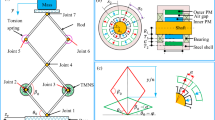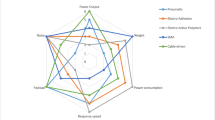Abstract
Rubber mount is a type of vibration isolator that can absorb vibration and minimize external disturbance. This study proposes an optimization method to design the geometry of a rubber mount to achieve particular stiffness values in two different loading directions. The proposed objective function of the geometry optimization problem is to minimize the error ratios between calculated and target stiffness values in vertical and transverse directions; a weighted sum method is used to combine both error ratios with equal weighting factors. The design variables are the coordinates of some design points which form the cross-section geometry of the rubber mount. A three-dimensional design is then obtained by extrusion of the two-dimensional geometry. Cuckoo search algorithm is used to update the design variables until the objective function value is smaller than a tolerance. Nonlinear finite element analysis is used to estimate the stiffness values of the rubber mount. Both hyperelastic and viscoelastic rubber parameters are numerically identified by fitting to the experimental data. An optimal design of the rubber mount is obtained and prototyped. Experimental tests are performed to validate the design.
Similar content being viewed by others
References
ANSYS Inc. (2019). ANSYS Mechanical APDL Help, Release 19.2.
Baranowski, P., Malachowski, J., Janiszewski, J. and Wekezer, J. (2016). Detailed tyre FE modelling with multistage validation for dynamic analysis. Materials & Design, 96, 68–79.
Berselli, G., Vertechy, R., Pellicciari, M., and Vassura, G. (2011). Hyperelastic modeling of rubber-like photopolymers for additive manufacturing processes. Rapid Prototyping Technology—Principles and Functional Requirements, 135–152.
Blum, C. and Roli, A. (2003). Metaheuristics in combinatorial optimization: Overview and conceptual comparison. ACM Computing Surveys 35, 3, 268–308.
Deaton, J. D. and Grandhi, R. V. (2014). A survey of structural and multidisciplinary continuum topology optimization: post 2000. Structural and Multidisciplinary Optimization 49, 1, 1–38.
Fazekas, B. and Goda, T. J. (2018). Determination of the hyper-viscoelastic model parameters of open-cell polymer foams and rubber-like materials with high accuracy. Materials & Design, 156, 596–608.
Guo, H., Chen, Y., Tao, J., Jia, B., Li, D. and Zhai, Y. (2019). A viscoelastic constitutive relation for the rate-dependent mechanical behavior of rubber-like elastomers based on thermodynamic theory. Materials & Design, 178, 107876.
Haftka, R. T. and Grandhi, R. V. (1986). Structural shape optimization—a survey. Computer Methods in Applied Mechanics and Engineering 57, 1, 91–106.
Kim, B, Lee, S. B., Lee, J., Cho, S., Park, H., Yeom, S. and Park, S. H. (2012). A comparison among Neo- Hookean model, Mooney-Rivlin model, and Ogden model for chloroprene rubber. Int. J. Precision Engineering and Manufacturing 13, 5, 759–764.
Kim, J. J. and Kim, H. Y. (1997). Shape design of an engine mount by a method of parameter optimization. Computers & Structures 65, 5, 725–731.
Kim, W. D., Lee, H. J., Kim, J. Y. and Koh, S. K. (2004). Fatigue life estimation of an engine rubber mount. Int. J. Fatigue 26, 5, 553–560.
Lee, C. R. and Jeong, H. Y. (2018). Development of headform impactor finite element model considering the hyperelastic and viscoelastic responses of rubber. Int. J. Automotive Technology 19, 3, 523–534.
Lee, K.-M. and Liu, C.-H. (2012). Explicit dynamic finite element analysis of an automated grasping process using highly damped compliant fingers. Computers and Mathematics with Applications, 64, 965–977.
Lee, W. S. and Youn, S. K. (2004). Topology optimization of rubber isolators considering static and dynamic behaviours. Structural and Multidisciplinary Optimization 27, 4, 284–294.
Li, Q., Zhao, J. C. and Zhao, B. (2009). Fatigue life prediction of a rubber mount based on test of material properties and finite element analysis. Engineering Failure Analysis 16, 7, 2304–2310.
Lim, J., Jang, Y. S., Chang, H. S., Park, J. C. and Lee, J. (2020). Multi-objective genetic algorithm in reliability-based design optimization with sequential statistical modeling: an application to design of engine mounting. Structural and Multidisciplinary Optimization, 61, 1253–1271
Liu, C.-H., Chen, T.-L., Chiu, C.-H., Hsu, M.-C., Chen, Y., Pai, T.-Y., Peng W.-G. and Chiang Y.-P. (2018a). Optimal design of a soft robotic gripper for grasping unknown objects. Soft Robotics 5, 4, 452–465.
Liu, C.-H., Chiu, C.-H., Hsu, M.-C., Chen, Y. and Chiang, Y.-P. (2019). Topology and size-shape optimization of an adaptive compliant gripper with high mechanical advantage for grasping irregular objects. Robotica 37, 8, 1383–1400.
Liu, C.-H., Chung, F.-M., Chen, Y., Chiu, C.-H. and Chen, T.-L. (2020). Optimal design of a motor-driven three-finger soft robotic gripper. IEEE/ASME Trans. Mechatronics 25, 4, 1830–1840.
Liu, C.-H., Huang, G.-F., Chiu, C.-H. and Pai, T.-Y. (2018b). Topology synthesis and optimal design of an adaptive compliant gripper to maximize output displacement. J. Intelligent & Robotic Systems 90, 3–1, 287–304.
Liu, C.-H. and Lee, K.-M. (2012). Dynamic modeling of damping effects in highly damped compliant fingers for applications involving contacts. ASME J. Dynamic Systems, Measurement and Control, 134, 011005.
Ogden, R. W. (1972). Large deformation isotropic elasticity-on the correlation of theory and experiment for incompressible rubberlike solids. Proc. Royal Society of London. A. Mathematical and Physical Sciences 326, 1567, 565–584.
Ooi, L. E. and Ripin, Z. M. (2011). Dynamic stiffness and loss factor measurement of engine rubber mount by impact test. Materials & Design 32, 4, 1880–1887.
Ooi, L. E. and Ripin, Z. M. (2014). Impact technique for measuring global dynamic stiffness of engine mounts. Int. J. Automotive Technology 15, 6, 1015–1026.
Park, C. H., Shim, H. J., Choi, D. H., Kim, J. K. and Lee, S. M. (2012). Shape optimization of rubber isolators in automotive cooling modules for the maximization of vibration isolation and fatigue life. Int. J. Automotive Technology 13, 1, 61–75.
Ramorino, G., Vetturi, D., Cambiaghi, D., Pegoretti, A. and Ricco, T. (2003). Developments in dynamic testing of rubber compounds: assessment of non-linear effects. Polymer Testing 22, 6, 681–687.
Rao, S. S. (2009). Engineering Optimization: Theory and Practice. 4th Edition. John Wiley & Sons. Hoboken, NJ, USA.
Rozvany, G. I. N. (2009). A critical review of established methods of structural topology optimization. Structural and Multidisciplinary Optimization 37, 3, 217–237.
Samur, E., Sedef, M., Basdogan, C., Avtan, L. and Duzgun, O. (2007). A robotic indenter for minimally invasive measurement and characterization of soft tissue response. Medical Image Analysis 11, 4, 361–373.
Sigmund, O. and Maute, K. (2013). Topology optimization approaches. Structural and Multidisciplinary Optimization 48, 6, 1031–1055.
Simo, J. C. (1987). On a fully three-dimensional finite-strain viscoelastic damage model: formulation and computational aspects. Computer Methods in Applied Mechanics and Engineering 60, 2, 153–173.
Wang, L. R., Lu, Z. H. and Hagiwara, I. (2010) Integration of experiment and hydrostatic fluid-structure finite element analysis into dynamic characteristic prediction of a hydraulically damped rubber mount. Int. J. Automotive Technology 11, 2, 245–255.
Wei, C. and Olatunbosun, O. A. (2016). The effects of tyre material and structure properties on relaxation length using finite element method. Materials & Design, 102, 14–20.
Yang, X. S. (2014). Nature-Inspired Optimization Algorithms. Elsevier. London, UK.
Yang, X. S. and Deb, S. (2009). Cuckoo search via Levy flights. World Cong. Nature & Biologically Inspired Computing (NaBIC). Coimbatore, India.
Yang, X. S. and Deb, S. (2010). Engineering optimization by cuckoo search. Int. J. Mathematical Modelling and Numerical Optimisation 1, 4, 330–343.
Yeoh, O. H. (1993). Some forms of the strain energy function for rubber. Rubber Chemistry and Technology 66, 5, 754–771.
Yu, Y., Naganathan, N. G. and Dukkipati, R. V. (2001). A literature review of automotive vehicle engine mounting systems. Mechanism and Machine Theory, 36, 123–142.
Yun, K. S. and Youn, S. K. (2017). Design sensitivity analysis for transient response of non-viscously damped dynamic systems. Structural and Multidisciplinary Optimization 55, 6, 2197–2210.
Acknowledgement
This work was supported by the grants from the Ministry of Science and Technology of Taiwan (grant number: MOST 108-2923-E-006-004-MY3), and Yen Tjing-Ling Industrial Development Foundation.
Author information
Authors and Affiliations
Corresponding author
Additional information
Publisher’s Note
Springer Nature remains neutral with regard to jurisdictional claims in published maps and institutional affiliations.
Rights and permissions
About this article
Cite this article
Liu, CH., Hsu, YY. & Yang, SH. Geometry Optimization for a Rubber Mount with Desired Stiffness Values in Two Loading Directions Considering Hyperelasticity and Viscoelasticity. Int.J Automot. Technol. 22, 609–619 (2021). https://doi.org/10.1007/s12239-021-0057-8
Received:
Revised:
Accepted:
Published:
Issue Date:
DOI: https://doi.org/10.1007/s12239-021-0057-8




